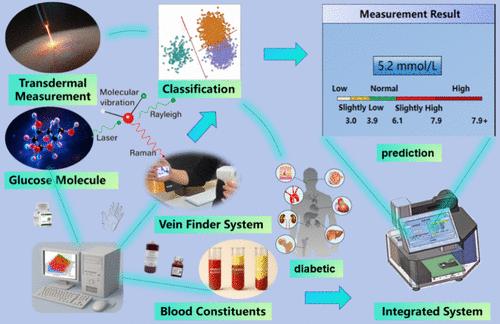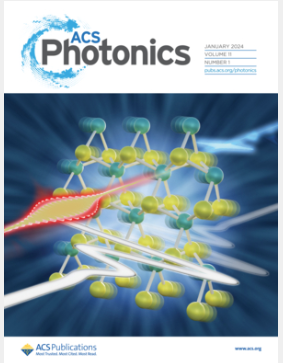通过静脉可视化引导的共聚焦拉曼光谱和异质集成学习进行无创血糖监测
IF 6.7
1区 物理与天体物理
Q1 MATERIALS SCIENCE, MULTIDISCIPLINARY
引用次数: 0
摘要
拉曼光谱有望实现无创血糖监测。但它的实际实施受到一些挑战的限制,比如采样位置不精确、葡萄糖特异性特征分辨率不高以及数据集小。为了克服这些限制,静脉可视化技术(VVT)首次与共聚焦拉曼光谱(CRS)系统相结合,以提高光谱采样精度和质量。此外,提出了一个结合多个异构基础模型的堆叠集成学习框架,以提高模型泛化,同时减少过拟合,从而实现准确的血糖预测。同时,采用内部标准方法,结合拉曼光谱智能增强引擎和特征选择驱动的叠加模型,扩展有效数据集规模,优化模型权重分配。为了验证方法,我们对合成血液样本和体内静脉血血糖进行回归分析,并根据不同的血糖水平对样本进行分类。结果表明,体外合成血实验中,葡萄糖峰面积比与浓度呈显著线性相关,回归R2值达到0.9897。在体内经皮试验中,VVT将静脉定位的准确性提高了约20%,预测值与参考值的回归R2达到0.928。在分类实验中,训练时采用2 mmol/L间隔的合成血得到了可靠的结果;当过渡到体内透皮测试时,迁移学习将区分餐前和餐后葡萄糖状态的准确性提高了2个百分点,达到92%。这些结果为基于人工智能的无创血糖监测技术的应用奠定了基础。本文章由计算机程序翻译,如有差异,请以英文原文为准。

Noninvasive Blood Glucose Monitoring via Vein Visualization-Guided Confocal Raman Spectroscopy and Heterogeneous Ensemble Learning
Raman spectroscopy holds promise for noninvasive glucose monitoring. But its practical implementation is constrained by challenges like imprecise sampling locations, poorly resolved glucose-specific features, and small data sets. To overcome these limitations, venous visualization technology (VVT) is, for the first time, integrated with a confocal Raman spectroscopy (CRS) system to improve spectral sampling precision and quality. Moreover, a stacking ensemble learning framework combining multiple heterogeneous base models is proposed to improve model generalization while mitigating overfitting for accurate glucose prediction. Meanwhile, an internal standard method, combined with the Raman spectrum intelligent augmentation engine and a feature selection-driven stacking model, is employed to expand the effective data set size and optimize model weight allocation. For method validation, regression analysis is conducted on synthetic blood samples and in vivo venous blood glucose, with classification of samples based on varying glucose levels. Results indicate that, for in vitro synthetic blood experiment, the glucose peak area ratio is significantly linearly correlated with concentration, with the regression R2 value reaching 0.9897. For the in vivo transcutaneous test, VVT enhances the accuracy of venous localization by approximately 20%, with the regression R2 between the predicted and reference values reaching 0.928. In the classification experiment, reliable results are obtained for synthetic blood using 2 mmol/L intervals during training; when transitioned to the in vivo transdermal test, transfer learning boosts the accuracy by 2 percentage points to 92% for distinguishing between pre- and postprandial glucose states. These results establish a foundation for the application of AI-based noninvasive glucose monitoring technology.
求助全文
通过发布文献求助,成功后即可免费获取论文全文。
去求助
来源期刊

ACS Photonics
NANOSCIENCE & NANOTECHNOLOGY-MATERIALS SCIENCE, MULTIDISCIPLINARY
CiteScore
11.90
自引率
5.70%
发文量
438
审稿时长
2.3 months
期刊介绍:
Published as soon as accepted and summarized in monthly issues, ACS Photonics will publish Research Articles, Letters, Perspectives, and Reviews, to encompass the full scope of published research in this field.
 求助内容:
求助内容: 应助结果提醒方式:
应助结果提醒方式:


